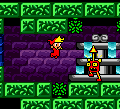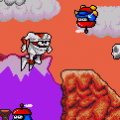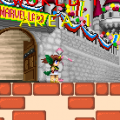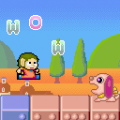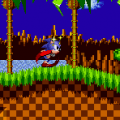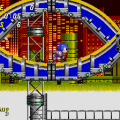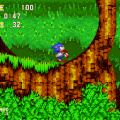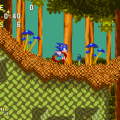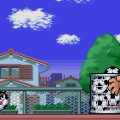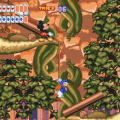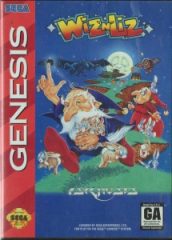
American Genesis Cover
The Amiga is a home computer not many people in the States know about, because it was only ever particularly successful in Europe. This meant that a lot of surprisingly good games slipped through the cracks, hidden away to most people until the days of modern emulation. A few games, however, made it onto consoles like the SNES and Genesis. Like this, for starters, a quirky little platformer by a small outfit known as Raising Hell Software. A developer, incidentally, that would go on to pick up the much more PC name of Bizzare Creations. The same who’d go on to achieve glory with Project Gotham Racing and Geometry Wars, yes.
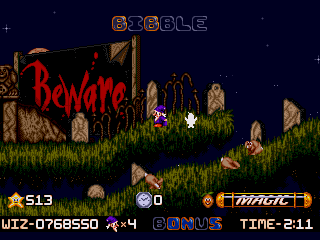
A long time before that tragic end, however, they released a quirky little game under the name of Wiz ‘n’ Liz. The best way to describe it would be a cross of a platformer and an arcade game, where going for the best scores matter just as much as surviving to the end of the game. There’s not a whole lot of plot involved, the whole thing being summarized by the intro cutscene at the start of the game. A wizard and a witch who own a lot of rabbits, for whatever reason, botch a magic spell, and all the rabbits end up getting scattered through a bunch of levels. That’s really all you’ve got to go on, not that you need much more than that. Sure, there are some bosses, but they’re just… kind of there, really.
From the main menu, you get a few options, including your choice of character. This doesn’t affect anything, aside from whether you’ll be starting at a wizard or a witch for the whole game, so pick whichever you want. The difficulty level determines how many worlds you can play through before the game ends, how much time you get, and the game’s general difficulty. The skill level changes how quickly you move, along with the speed of the timer. Keep in mind that, much like so many other games from the ’90s, if you don’t have both the difficulty settings set at least to the middle option, the game won’t cough up a decent ending.
When you start a game, you start on the home stage, a small forest with a cottage and cauldron. To actually enter the level select screen itself, you have to pick up two of the fruits hanging from the trees, put them in the cauldron, and have them mix together to create a door that’ll bring you to the levels proper. While you’re in the home stage, you’re in no danger, so this makes a good spot to get used to how the game controls. Once you enter the door to the level select screen, you’re given a bunch of doors that’ll take you to different levels. You’re free to tackle them in any order you want, but you’ll only get to the world boss once you clear all the stages in a world first.
The first thing you’ll notice once you start an ordinary stage is that Wiz ‘n’ Liz is not your ordinary platformer. For one thing, there aren’t any enemies. Neither are there any environmental hazards, or any pits to fall into. There aren’t even any walls. It’s just you, some platforms, and tons and tons of wabbits. All the levels wrap around infinitely, no matter how many times you run around it, and they’re all only a few screens or so in length. The first thing you need to do once a level starts is to pick up enough of the wabbits that spawn to spell out a magic word, which will always be some kind of gibberish like “MACKLE” or “PONGO”. Some wabbits you pick up will drop a flying letter, and once you spell out the word, a door will appear on the map. Once you’ve done that, you’ll have to collect a certain number of wabbits to actually open up the exit door.
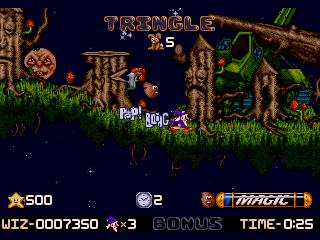
The rabbit quotas will start out small, but they’ll steadily get higher and higher as you clear stages, until you have to pick up 60 or so wabbits before the door will open. Finish so many rounds of this, and you clear the stage. The wabbits will also drop stars, extra time, and fruit. Each round has a fruit meter that fills up every time you pick up fruit, and once you fill it up, a piece of fruit will appear on the home stage. OK, technically it’s not ALL fruit, since there’s also stuff like potatoes, carrots, and cabbages to collect, but still. It’s generally in your best interest to get the fruit, since it’ll help you out in the long run. Don’t take too long grabbing the wabbits, by the way, because at a certain point into the game, certain wabbits will start to flash. This is a warning they’re about to explode, and if you don’t pick them up before they do, they’ll take all your letters with them and make you collect them all again.
Now, you might be thinking that a game without any enemies or hazards would be incredibly easy to finish. This game will be happy to prove you wrong. See, your true enemy in this game is the timer, a clock leading to your inevitable death that cannot be stopped, only delayed. Depending on your difficulty, you’re given either one or two minutes to live. Once time runs out, you’ll die and lose one of your three lives. Keep in mind that the timer will NOT reset itself between stages, so whatever amount of time you had in the last level is what you’ll get in the next. There are a few ways to extend the timer, mostly by collecting the time icons that sometimes appear from the wabbits you pick up. Each icon you collect will give you three extra seconds at the end of the round. It might sound like a lot, but with the wabbit quotas the game gives you, it really isn’t. Once you hit the ten second mark, one of the wabbits will be carrying a powerup that’ll give you 30 seconds of extra time. Actually finding it before the clock runs out, however, is a crapshoot in itself.
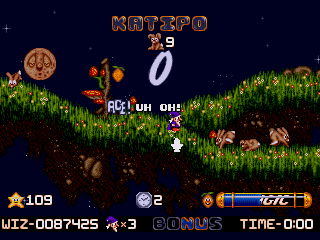
There is, however, one thing you can do to turn things in your favor. Every piece of fruit you end up earning in the main levels will show up in your home stage for you to use later. By mixing two fruit together in your cauldron, you can cause a whole variety of different things to happen. While the first combination of fruit you make will always create a door to the stage select, after the first level, every combination of two fruits will cause something different to happen. If you can memorize which combinations do what, you’ll have a distinct advantage over the timer . Fruit will also carry over between levels, but they will eventually go bad and disappear, so you don’t want to hoard them for too long.
There’s a couple of dozen or so different effects from the fruit combinations, some much more useful than others. Some combinations will you give you stuff like extra time, extra points, or let you skip a level. One of the most important combinations is with an apple and a banana, which will open up a store where you can use the stars you collect to buy more fruit, time, and extra lives. Opening up the shop is probably the most important thing you can do, because it gives you access to any combination of fruit in the game, provided you have the starts to buy them. A lot of these combinations are quite useful, like increasing your points, your time, making it so wabbits will no longer explode, or making it so that instead of the wabbits dropping fruit, they’ll drop extra time icons. Most of these effects only last for the next level, but they’ll greatly increase your chances of survival.
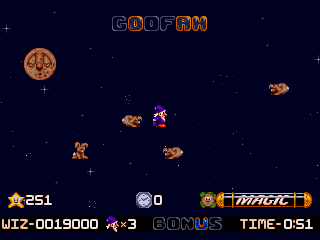
You can also unlock a few different minigames with the right combinations, too. There’s a quiz game where you can bet stars, for one thing. You know those nonsense words you keep collecting to open up the exit? Yeah, those are real. (Protip: Polowac is actually coconut pulp, not another name for your buttocks. The more you know!) There’s also a minigame where you throw tomatoes at what are presumably caricatures of two of the game’s developers, with an extra life in it for you if you do especially well. Also, Puggsy from the Genesis game of the same name is also there, because… well, he just is. Those aren’t the only minigames, either, but the rest are worth discovering through rote memorization and note taking. Or GameFAQs.
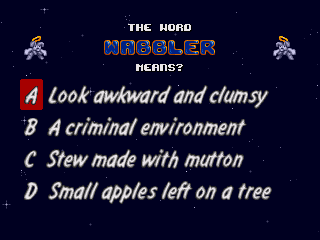
At the end of each “world”, you’ll get into a boss fight, fighting such enemies like a giant clock, a giant pumpkin, or a giant snake. The theme goes on like that. These fights are the only actual point in the game where you have any actual conflict, and as such, play pretty differently to the rest of the game. In the boss fights, the A button lets off a beam of magic that homes in on the boss and deals damage to it. You don’t have to aim, but it will take a few seconds to recharge if you use it for too long. You also get a health bar with about five or so hits on it, and if it runs out, you lose a life and have to redo the fight.
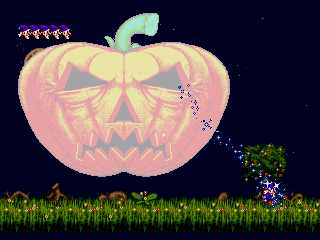
Most of the bosses are pretty easy, since they all mostly float around and perform one attack again and again. They don’t really animate, aside from taking visible damage as you drain their health. The giant flower, for example, will lose its eyes, which actually looks way creepier than you’d think for a game like this. The final boss, a dragon that takes almost the entire screen, is actually the most impressive of them all, given that not only does his head follow you as you move around, but he gets two different attacks, both of which are actually pretty tough to dodge. Once you beat a boss, you go on to the next world, with a new set of levels. Every world has the same set of levels, but the platforms in them will be arranged in different ways, and they’ll have some new background graphics. The game will also gradually get tougher by increasing the rabbit quotas and giving you more rounds to play through before you can finish a stage, draining away more of your time.
There’s also a competitive two-player mode, where Wizzy and Lizzy race to collect enough wabbits to open up the exit and leave the stage before the other. There’s no real way to attack or slow down your opponent, and since each player can only collect a certain color of wabbit, you can’t even steal the other player’s wabbits and screw them over. Still, it’s reasonably entertaining, if not especially deep. Sadly, though, the game doesn’t have any sort of co-operative mode, which would be perfect for a game like this.
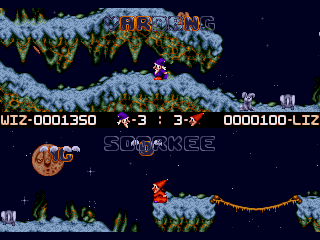
The game looks pretty good, and even with the sprites being as small as they are, and they all animate pretty smoothly. There’s also a cute touch where everything you pick up gives off an onomatopoeia like “ACE” or “WIZ”. The levels themselves are all a static bunch of platforms, although they all have certain background objects that change depending on the world. You might find the ruins of the Statue of Liberty in the background of Desert Land, while one of the Temple Land stages has a giant rabbit that’s much more realistically drawn than anything else in the game, which makes it look strangely terrifying. The music was done by the always fantastic Matt Furniss, and he never fails to disappoint. The highlight would probably be the high score music, which goes on long enough that it sounds more suited for the credits, then anything else. Most of the music tends to be up tempo and cheerful, even when you’re running through what’s basically a giant graveyard.
What really needs to be called to attention, however, is the moon. The moon stays in the background for pretty much the entire game, showing up on every single level. For the most part, it just tends to sleep, yawning every so often. Every once in a while, though, it’ll wake up, grinning directly at you, the player, in a way that would make the moon from Majora’s Mask whimper and back away slowly. The damn thing will even start roaring at you a few times, before eventually settling back to sleep. You might think that the moon will probably end up being the true mastermind of whatever plot the game has, but sadly, it is not. Wasted opportunity, there.
Overall, Wiz ‘n’ Liz is a very unusual platformer, one that breaks nearly all the established “rules’ of the genre”. It’s still a pretty enjoyable game, for all its weirdness. It basically breaks every established rule of the genre, yet it’s still worth playing in quick bursts. It’s got a weird sense of humor, a lot of secrets and easter eggs to find, (including more than a few references to other Psygnosis games) a great soundtrack, and while it may be too difficult for its own good, at times, it’s still very much worth playing. Bizzare Creations would go on to make more than a few other games, until their eventual sad demise at the hands of Activision.
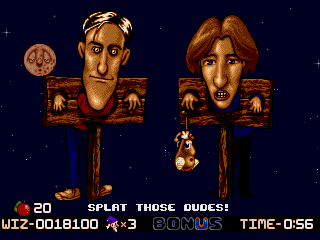
Unless you want to shell out for an Amiga, the Genesis version is probably your best bet. The thing is, however, that the Genesis version is better in pretty much every way. The Amiga version has the usual disk loading times to deal with, less speed than the Genesis version, no starfield background (and no moon, although that’s not entirely a bad thing), and the music just isn’t as good. It’s amazing just how much better the Genesis version is, given that both versions came out on the same year.
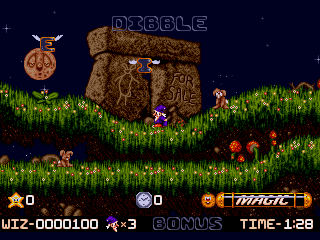
Genesis
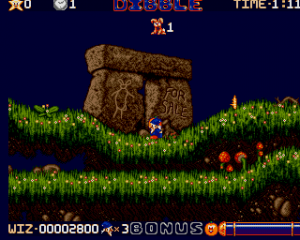
Amiga

